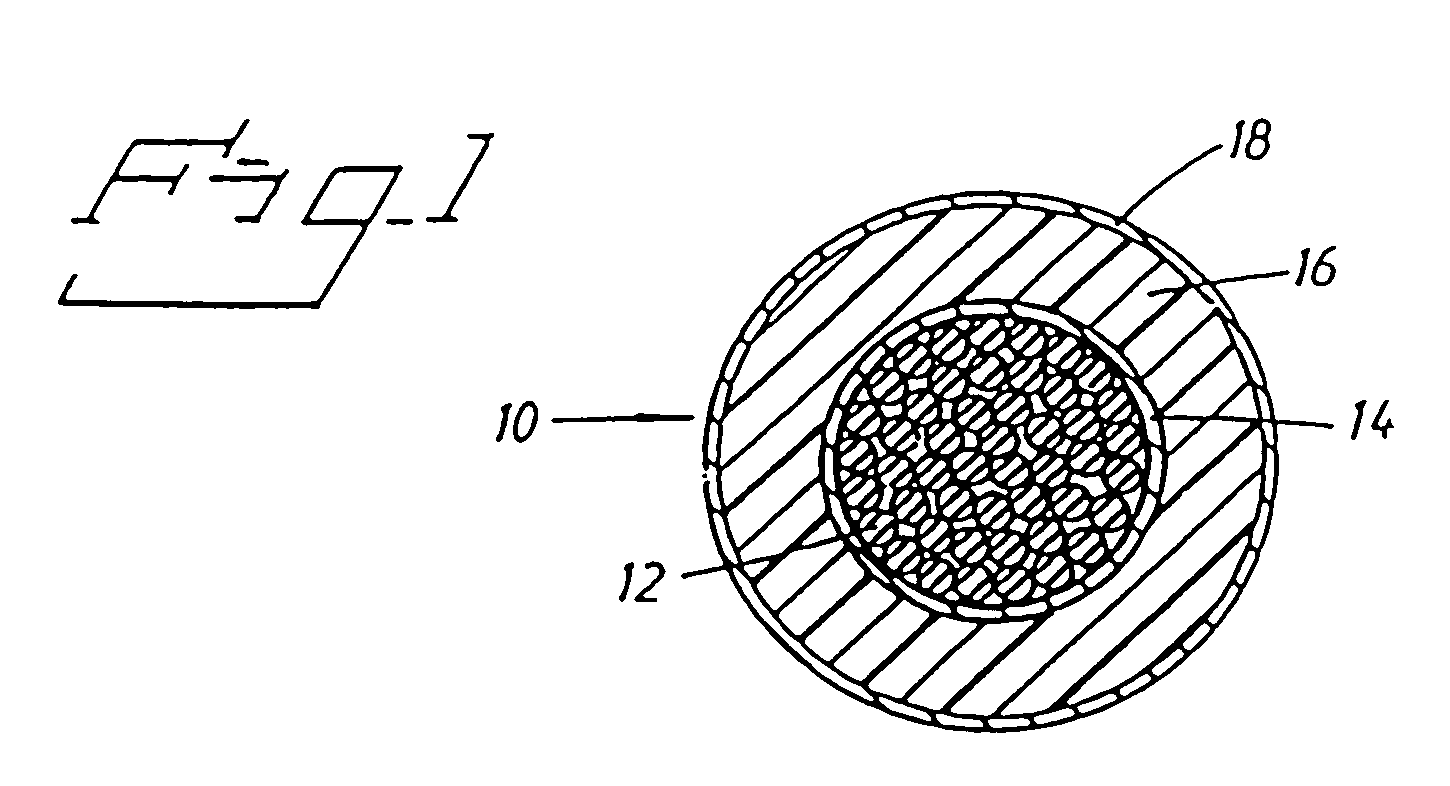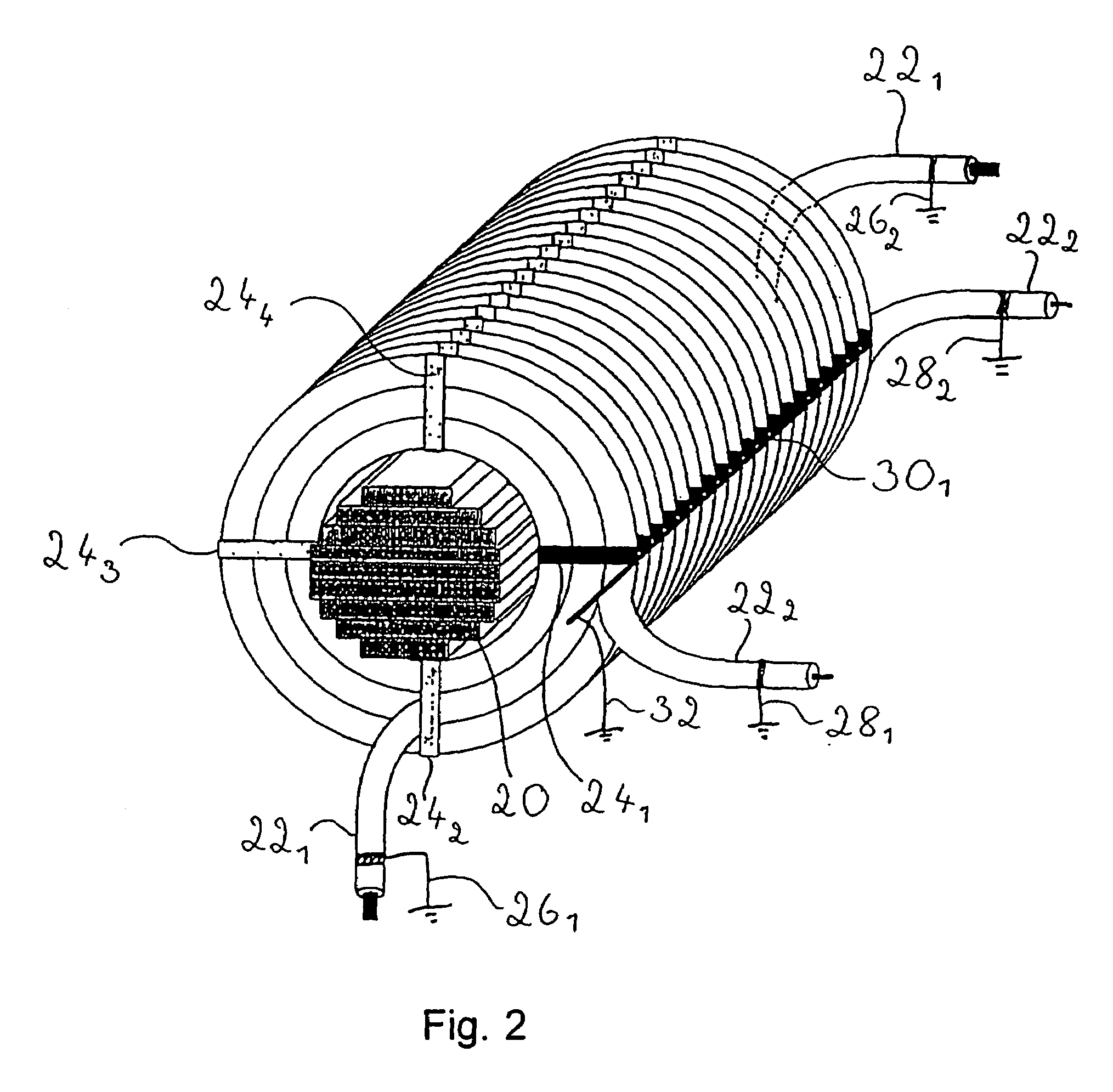Power transformer/inductor
- Summary
- Abstract
- Description
- Claims
- Application Information
AI Technical Summary
Benefits of technology
Problems solved by technology
Method used
Image
Examples
first embodiment
[0046]FIG. 3 shows a perspective view of windings with two earthing points per winding turn according to the present invention. In FIGS. 2 and 3 the same parts are designated by the same numerals in order to make the Figures more clear. Also in this case the two windings 221 and 222, formed from the high-voltage cable 10 shown in FIG. 1, are arranged around the core leg 20. Spacer member 241, 242, 243, 244 are also in this case radially arranged with the aim of fixing the windings 221 and 222. At both ends 261, 262, 281, 282 of each winding 221 and 222 the second semiconducting layer (compare with FIG. 1) is earthed in accordance with FIG. 2. Spacer members 241, 243, which are marked in black, are used in order to achieve two earthing points per winding turn. Spacer member 241 is directly connected to a first earthing element 301 and spacer member 243 is directly connected to a second earthing element 302 at the periphery of the winding 222 and along the axial length of the winding ...
second embodiment
[0047]FIG. 4 shows a perspective view of windings with three earthing points per winding turn according to the present invention. In FIGS. 2–4 the same parts are designated by the same numerals in order to make the Figures more clear. Also here two windings 221 and 222, formed from the high-voltage cable 10 shown in FIG. 1, are arranged around the core leg 20. Spacer members 241, 242, 243, 244, 245, 246, are also radially arranged with the aim of fixing windings 221 and 222. As shown in FIG. 4 there are 6 spacer members per winding turn. At both ends 261, 262; 281, 282 of each winding 221, 222 the outer semiconducting layer (compare with FIG. 1) is earthed as in accordance with FIGS. 2 and 3. Spacer members 241, 243, 245 which are marked in black are used to achieve three earthing points per winding turn. These spacer members 241, 243, 245 are accordingly connected to the second semiconducting layer of the high power cable 10. Spacer member 241 is directly connected to a first earth...
third embodiment
[0048]FIGS. 5a and 5b respectively, show a perspective view respectively and a sectional view of a winding on an outer leg of a three phase transformer with three legs with three earthing points per winding turn according to the present invention. In FIGS. 2–5 the same parts are designated the same numerals in order to make the Figures more clear. A winding 221, formed from the high-voltage cable 10 shown in FIG. 1, is arranged around the outer leg 20 of the transformer. Additionally in this case spacer members 241, 242, 243, 244, 245, 256 are arranged radially with the aim of fixing the winding 221. At both ends of the winding 222 the second semiconducting layer (compare with FIG. 1) is earthed (not shown in FIGS. 5a and 5b respectively). Spacer members 241, 243, 245, which are marked in black, are used to achieve three earthing points per winding turn. Spacer member 241 is directly connected to a first earthing element 301, spacer member 243 is directly connected to a second earth...
PUM
 Login to View More
Login to View More Abstract
Description
Claims
Application Information
 Login to View More
Login to View More - R&D
- Intellectual Property
- Life Sciences
- Materials
- Tech Scout
- Unparalleled Data Quality
- Higher Quality Content
- 60% Fewer Hallucinations
Browse by: Latest US Patents, China's latest patents, Technical Efficacy Thesaurus, Application Domain, Technology Topic, Popular Technical Reports.
© 2025 PatSnap. All rights reserved.Legal|Privacy policy|Modern Slavery Act Transparency Statement|Sitemap|About US| Contact US: help@patsnap.com



